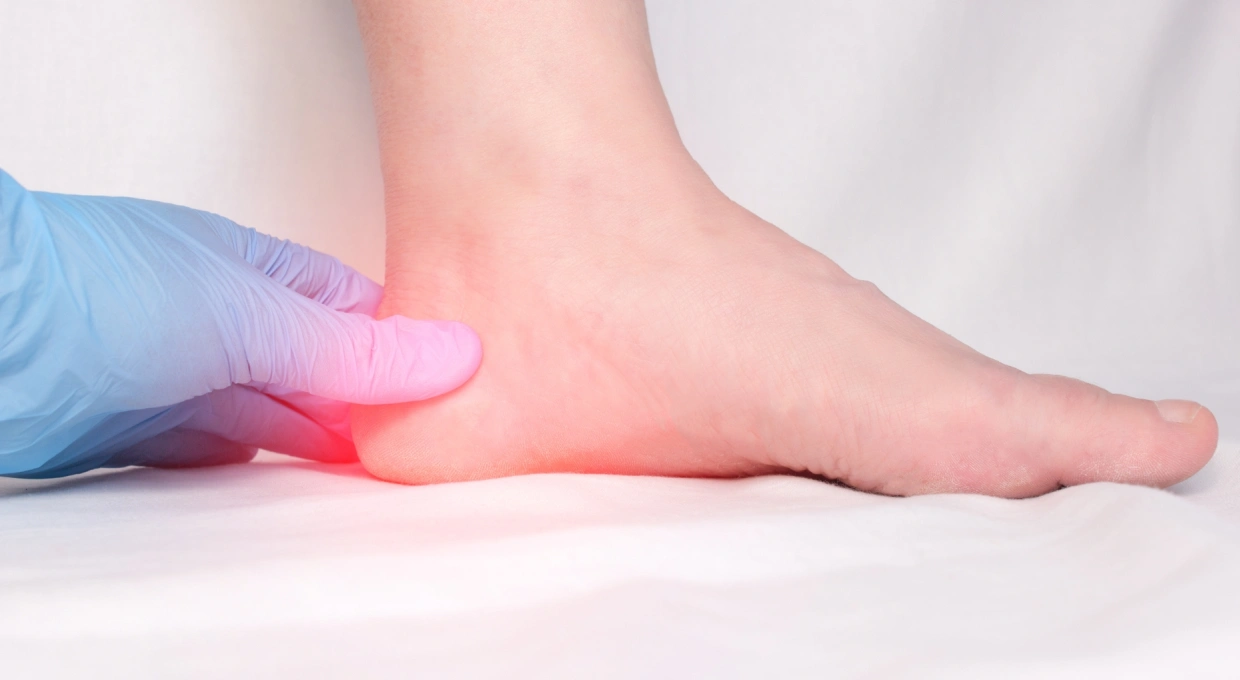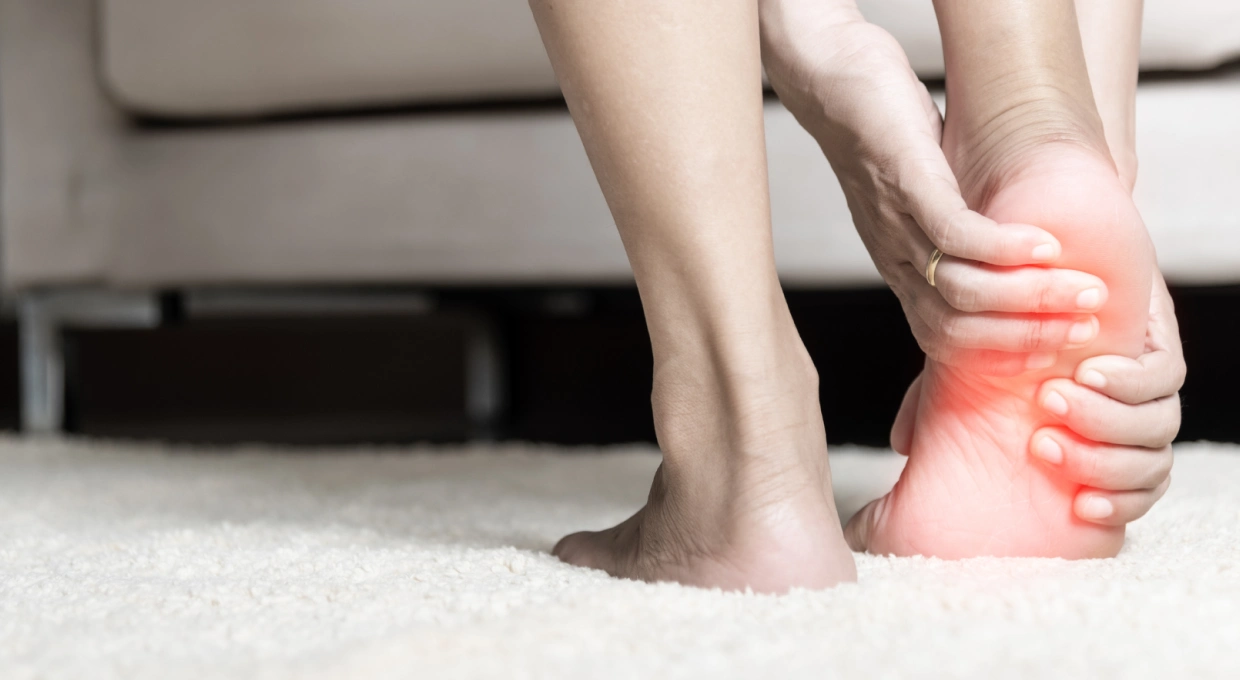Plantar fasciitis is one of the leading causes of heel pain, affecting millions of people worldwide. This condition occurs when the plantar fascia, a ligament that connects the heel to the forefoot, becomes inflamed. Below, we explore in detail the causes, symptoms, diagnostic methods, treatments and prevention strategies for plantar fasciitis.
Causes of Plantar Fasciitis
Plantar fasciitis can develop due to a combination of factors, including:
- Mechanical Overload: Repetitive pressure on the plantar fascia, common in runners and people who spend a lot of time standing.
- Biomechanical abnormalities: High arches, flat feet or an abnormal gait may contribute to fascial tension.
- Inadequate Footwear: Wearing shoes without sufficient support or cushioning can aggravate the condition.
- Risk Factors: Obesity, aging and certain occupations that require prolonged standing increase the risk of developing plantar fasciitis.
Common Symptoms
Symptoms of plantar fasciitis include:
- Heel Pain: Especially intense in the morning or after prolonged periods of rest.
- Stiffness and tenderness: In the lower part of the foot, which may worsen with activity.
- Inflammation: In some cases, there may be swelling and redness in the affected area.
Diagnosis
The diagnosis of plantar fasciitis is usually based on:
- Clinical History: Evaluation of the patient’s symptoms and medical history.
- Physical Examination: Palpation of the foot to identify areas of tenderness and pain.
- Diagnostic Imaging: In severe or persistent cases, X-rays, ultrasound or MRI may be used to rule out other conditions.
Treatments
Treatment of plantar fasciitis may include a combination of conservative approaches and, in severe cases, more advanced interventions. The most common treatment methods are:
- Rest and Activity Modification: Avoid activities that exacerbate pain and allow the foot to rest.
- Physical Therapies: Stretching and strengthening exercises for the plantar fascia and Achilles tendon.
- Use of Insoles and Orthotics: Customized insoles provide additional support and redistribute pressure on the foot.
- Medications: Nonsteroidal anti-inflammatory drugs (NSAIDs) to reduce pain and inflammation.
- Advanced Therapies: Shock wave therapy, corticosteroid injections and, in some cases, surgery to release the plantar fascia.
Conservative Treatments in Detail
Conservative treatments are the first line of defense against plantar fasciitis. These may include a combination of rest, ice, and stretching, as well as footwear modifications.
- Rest: Rest is essential to reduce inflammation and allow the plantar fascia to recover. It is recommended to avoid activities that exacerbate pain, such as running or standing for long periods.
- Ice: Applying ice to the affected area can help reduce inflammation and pain. It is recommended to apply ice for 15-20 minutes several times a day.
- Stretching: Stretching exercises are essential for relieving tension in the plantar fascia. Stretching the calf muscles and plantar fascia can help reduce pain and improve flexibility.
- Proper Footwear: Wearing shoes with good arch support and adequate cushioning is crucial to reduce pressure on the plantar fascia. Avoid wearing flat shoes and opt for those with cushioned soles and adequate arch support.

Advanced Treatments
When conservative treatments are not sufficient to relieve the symptoms of plantar fasciitis, advanced treatments may be considered. These may include:
- Shock Wave Therapy: Shock wave therapy is a non-invasive treatment that uses high-energy sound waves to stimulate healing in the affected area. This treatment can be effective in reducing pain and inflammation in patients with chronic plantar fasciitis.
- Corticosteroid Injections: Corticosteroid injections can be used to reduce inflammation and pain in severe cases of plantar fasciitis. However, it is important to note that repeated use of corticosteroids can weaken the plantar fascia and increase the risk of rupture.
- Surgery: In extremely severe cases where other treatments have been unsuccessful, surgery may be necessary. Surgical procedures may include release of the plantar fascia or removal of bone spurs if present. Surgery for plantar fasciitis is generally considered as a last resort and only after all non-invasive treatment options have been exhausted.
Prevention
To prevent plantar fasciitis, several strategies can be adopted:
- Proper Footwear: Wear shoes with good arch support and adequate cushioning.
- Weight Control: Maintain a healthy weight to reduce pressure on the feet.
- Stretching and Strengthening Exercises: Perform regular exercises to maintain flexibility and strength in the feet and legs.
- Avoid Overactivity: Gradually increase the intensity of physical activities to avoid overload.
Lifestyle and Prevention
Adopting a healthy lifestyle and making changes in footwear and daily activities can help prevent plantar fasciitis. Here are some recommendations:
- Regularly Change Shoes: It is important to replace worn-out shoes regularly, as support and cushioning can degrade over time.
- Perform Low-Impact Exercise: Opting for low-impact physical activities such as swimming or cycling can reduce pressure on the plantar fascia.
- Maintain a Stretching Routine: Incorporating regular stretches for the feet and legs into your daily routine can help maintain flexibility and prevent stiffness.
Impact on Quality of Life
Plantar fasciitis can have a significant impact on the quality of life of those affected. Chronic pain can limit daily activities and the ability to exercise, affecting both physical and emotional health. It is crucial to seek early treatment and follow medical recommendations to minimize this impact.
Conclusion
Plantar fasciitis is a painful but treatable condition that affects the plantar fascia in the foot. With proper diagnosis and a comprehensive treatment approach that includes lifestyle changes, physical therapies and, in necessary cases, advanced medical interventions, patients can find relief and improve their quality of life. At Clinica San Roman, we offer a full range of treatments for plantar fasciitis, ensuring comprehensive and personalized care for each patient.



